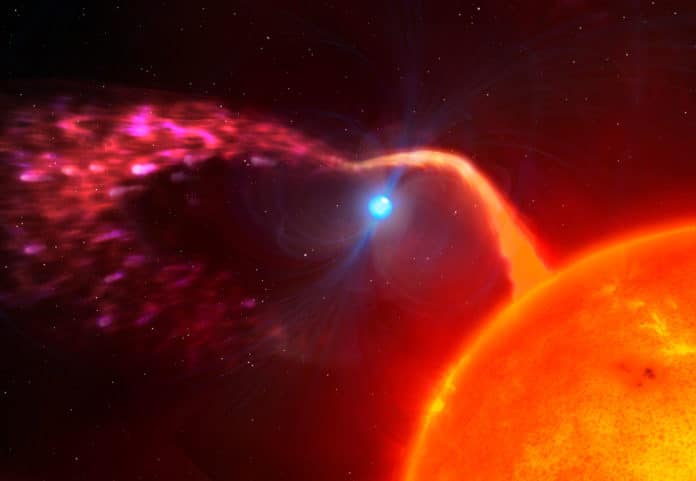A team of astronomers at the University of Warwick recently confirmed the fastest-spinning white dwarf. By establishing the pin period of the star for the first time, astronomers confirmed that the white dwarf named LAMOST J024048.51+195226.9 – or J0240+1952 for short is an extremely rare example of a magnetic propeller system.
Astronomers noted a white dwarf star that completes a full rotation once every 25 seconds. It is the fastest-spinning confirmed white dwarf. With such a record-breaking spin rate, the star is the second high-speed magnetic propeller.
The team made the discovery using data from a combination of powerful and sensitive instruments. These instruments allowed scientists to catch a glimpse of the speeding star.
The star J0240+1952 is similar to Earth but is thought to be at least 200,000 times more massive. The data suggests that the star is part of the binary star system. Its immense gravity is pulling material in the form of plasma from its companion star.
In the past, the plasma was falling in the star’s equator at extremely high speed. This gives the star its dizzyingly fast spin of 25 seconds. That’s almost 20% faster than the confirmed white dwarf with the most comparable spin rate, which completes a rotation in just over 29 seconds.
With time, this fastest-spinning white dwarf developed a strong magnetic field. This magnetic field acts as a protective barrier, causing most of the falling plasma to be propelled away from the white dwarf. The remaining flow towards the star’s magnetic poles.
It gathers in bright spots on the star’s surface, and as these rotate in and out of view, they cause pulsations in the light. Astronomers use this light to observe the stars from Earth. This light is then used to measure the rotation of the entire star.
The team visualized the star by using a susceptible HiPERCAM instrument.
Lead author Dr. Ingrid Pelisoli of the University of Warwick Department of Physics said, “J0240+1952 will have completed several rotations in the short amount of time that people take to read about it; it is incredible. The rotation is so fast that the white dwarf must have an above-average mass to stay together and not be torn apart.”
“It is pulling material from its companion star due to its gravitational effect, but as that gets closer to the white dwarf, the magnetic field starts to dominate. This type of gas is highly conducting and picks up a lot of speed from this process, which propels it away from the star and out into space.”
Antonio Cabrera, Head of GTC Science Operations, said, “These kinds of studies are possible thanks to the unique combination of the fast imaging capability of HiPERCAM with the largest collecting area in the world provided by GTC.”
Co-author Professor Tom Marsh from the University of Warwick Department of Physics adds: “It’s only the second time that we have found one of these magnetic propeller systems, so we now know it’s not a unique occurrence. It establishes that the magnetic propeller mechanism is a generic property that operates in these binaries if the circumstances are right.”
“The second discovery is almost as important as the first as you develop a model for the first, and with the second, you can test it to see if that model works. This latest discovery has shown that the model works really well; it predicted that the star had to be spinning fast, and indeed it does.”
Journal Reference:
- Ingrid Pelisoli et al. Found: a rapidly spinning white dwarf in LAMOST J024048.51+195226.9. DOI: 10.1093/mnrasl/slab116
